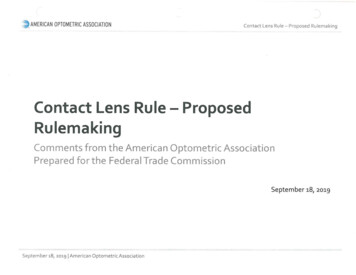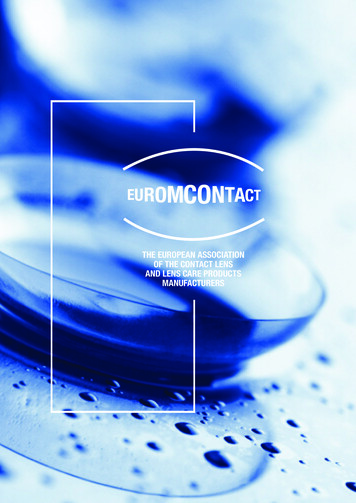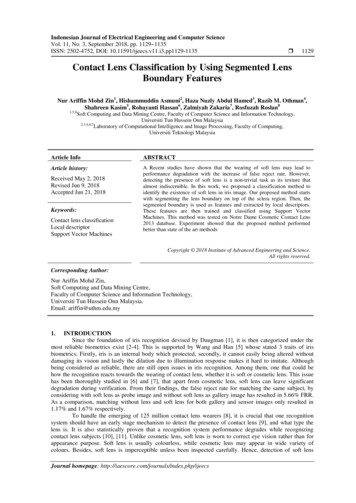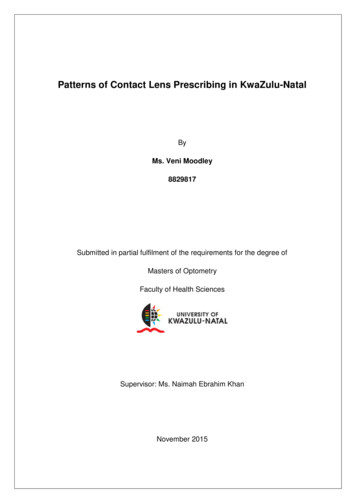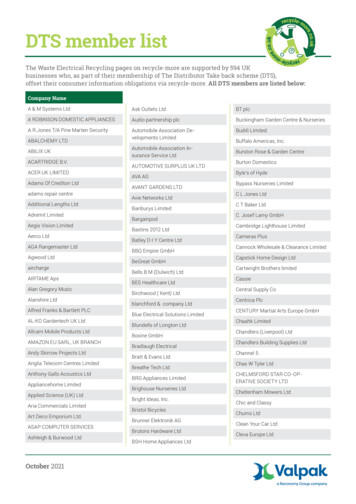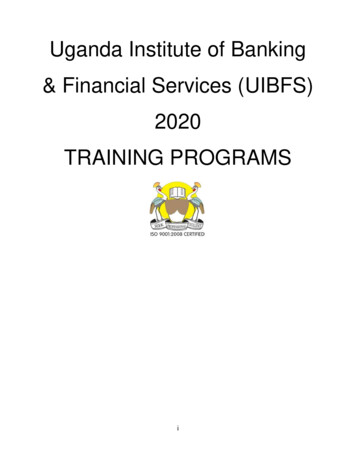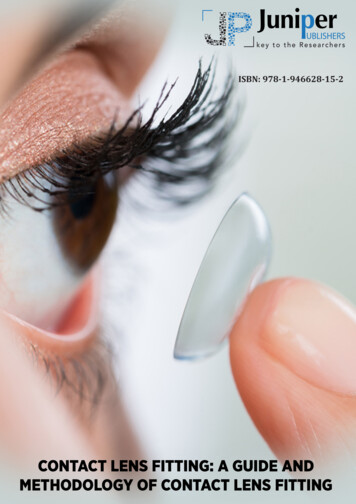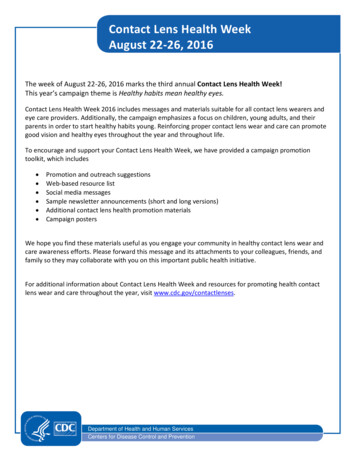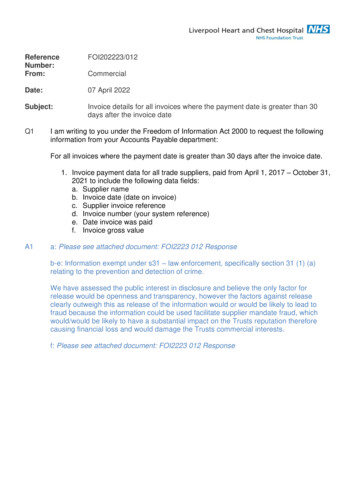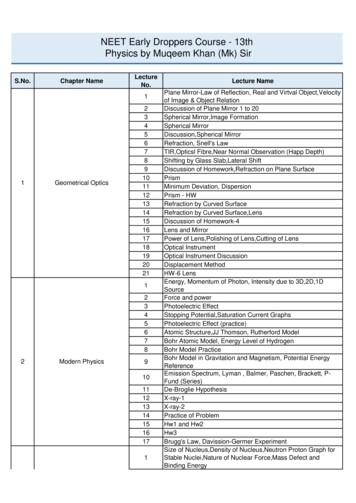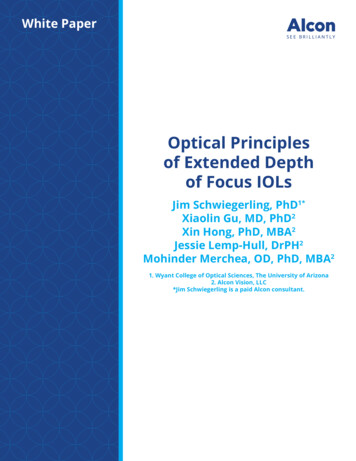
Transcription
Essential Contact Lens PracticeMedical LtdSoft ContactLens Fittingkey pointsKey PointsOptimising soft lens fit is animportant consideration.An ideally fitting soft contactlens should show the followingattributes: Comfort ( 9/10) C risp, clear and stablevision F ull corneal coverage in allgaze positions R egular edge alignment toconjunctiva S mooth recovery frompush-up A dequate movement fortear exchange 0.2 – 0.4mmLens fit and base curveselection are independentof K-readings.The push-up test is ofmore value than post-blinkmovement.Soft contact lenses continue to dominate mostcontact lens markets, accounting for about 90per cent of all fits worldwide.1 Options availableto the practitioner continue to evolve in lensmaterials, designs and replacement frequencies. Although hydrogel lenses continue to dominate, prescribing of silicone hydrogel lenses isincreasing, accounting for almost one-quarterof soft lens fits globally. As efforts to improvepatient satisfaction and long-term contact lenssuccess continue, attention to lens selectionand optimisation of fit should not be ignored.Although there are fewer parameters to consider when fitting soft lenses, it is still of upmostimportance to assess fit accurately.Adopt a routine assessment,moving from the least to themost invasive technique.49
Sof t Contact Lens FittingPFigure 1 Lens fit in primary positionof gazerescribing the right material, lens dimensionsand wearing modality to match a wearer’s oculartopography and lifestyle, should be the goal of everycontact lens practitioner. Sub-optimal fit or inappropriatelens selection can result in discomfort and/or have potentialphysiological impact, which can contribute to contact lenswear discontinuation.2 Experiences with the first generationhigher modulus silicone hydrogel lenses remind us of theimportance of optimal fit.It has been argued that the skill in contact lens practice hasmoved from the mechanics of lens fitting to monitoring theocular physiology of the patient. Nowhere is this truer thanin soft lens fitting, where options available to practitioners areoften limited to a ‘one-fit’ lens design. Although one-fit lensesmay achieve a high percentage of acceptable fits, understandinghow to assess and optimise lens fit remains key.Figure 2 Insufficient cornealcoverage and associateddesiccation stainingMany myths surrounding soft contact lens fitting and designhave been summarised in the literature.3 This article providesa practical overview of the key aspects of soft contact lensfitting principles. It does not deal with specific products.All the rules that apply to hydrogel lens fitting also apply tosilicone hydrogel materials.The ideal soft contact lens fitJudging the fit involves evaluating both static and dynamiccriteria. The ideal soft contact lens fit should show thefollowing characteristics:Corneal coverageThe lens should cover the cornea in primary gaze (Figure 1)and in all positions of gaze. This is to avoid desiccation of anexposed cornea, leading to epithelial staining (Figure 2).Dynamic fitThe lens must allow tear exchange to enable metabolic debrisfrom the cornea to be excreted. It is now well established thatsoft contact lens movement plays only a minor role in cornealoxygenation. The tear pump effect for soft lenses is minimalcompared to a rigid lens. This is significant in managing thesoft contact lens patient. The practitioner should not increaselens movement to alleviate hypoxic signs in the hydrogel lenswearer.
Essential Contact Lens PracticeAlignmentThe lens should align with the cornea and the conjunctiva, andnot indent conjunctival vessels. Indentation would indicatestagnation of tears in this region and reduced oxygen supplyto the limbus. Similarly, the lens should also show no edgestandoff (fluting), which would lead to discomfort.Lens centrationThe lens should remain approximately central to the corneain all positions of gaze. Failure to achieve this may result inepisodes of corneal desiccation and mechanical stress on theperipheral cornea.Patient responseWhen the above criteria are attained, the patient shouldachieve a high level of comfort and crisp stable vision.Table 1 summarises both the physical fit and performancerequirements.Instrumentation — keratometryTrial lens selectionKeratometry readings are a poor indication of a soft lens fit,and several studies, such as Gundal, 4 have shown no correlationbetween either central or peripheral K-readings and the bestfitting soft contact lens. Despite this, fitting guides continueto be produced in which K-readings are quoted as beingmeasurements on which the initial base curve is selected. Thereason why K-readings do not predict a soft lens fit has beenexplained by Young.5 The relationship between the sagittaldepth (sag) of the lens and the sagittal height of the anteriorsegment of the eye over the lens diameter determines the fitof the lens.Theoretically, if the lens sag is greater than the ocular sag, thelens will fit steeply, and vice versa. By using a mathematicalmodel to calculate ocular sag and then inputting normal rangesof values for each variable with the model, Young showed thatthe normal population variability in shape factor had a greatereffect on sag than either cornea radius or diameter.Baseline dataAlthough keratometry does not play a role in the selection ofthe initial trial lens, baseline keratometry readings should betaken for comparative purposes with time.Judging lens fitThe quality of the keratometer mires pre- and post-blink canbe used to help to judge fitting characteristics. The mires51
Sof t Contact Lens Fittingperformancephysical fitComfortableStable visionCentred on eyeFull corneal coverage in all positionsof gazeSufficient movementConforms to anterior eye topographyTablE 1Soft lens fitting requirementsFigure 3 Superimposedmeasurement cursor illustrating1 mm (left) and 0.3 mm (right)should remain clear at all stages. With a steep fitting lens, themires will look blurred prior to a blink and clear post-blink.With a loose fitting lens, the converse will occur. While thisis often cited as a method for judging the lens fit, the authorsbelieve this method has limited application to modern thinlens designs.Corneal topographyCorneal topography can be used to locate the apex of the cornea. This is valuable because the lens will centre on the cornealapex rather than on the geometric centre of the cornea. If theapex is displaced, the lens will decentre. Locating the apex willhelp in determining the best management option to overcome it.PD ruleThe normal PD rule may be used for measuring gross externalparameters. Horizontal visible iris diameter (HVID) is of valueto the soft lens fitting and will act as a determinant of totaldiameter. The HVID must be at least mm less than the TD ofthe lens to be fitted. Measuring the anterior segment by usingsuch a ruler is a crude method, so a graticule on the slit lampshould be used.BiomicroscopyThe biomicroscope is an essential tool. In soft lens fitting,its primary purpose is to allow the practitioner to judge, andthen record, the fit of the lens on the eye. In soft lens fitting, inaddition to recording lesions and anterior segment measurements, slit lamp graticule also allows the practitioner to assessaccurately the precise post-blink movement of a contact lens.While many texts and fitting guides refer to an optimallyfitting soft contact lens as being mm, the actual post-blinkmovement usually measures 0.2mm to 0.4mm. In Figure 3,a cursor is superimposed on the eye to demonstrate just how‘big’ mm looks through a slit lamp. A lens that moves as muchas the marker does in Figure 3a, would be judged by mostpractitioners as showing excessive movement, even though therecorded measurement is 1mm. In fact, the amount shown inFigure 3b is closer to that typically seen in a soft contact lens,and, in this case, is 0.3mm.
Essential Contact Lens PracticeThe slit lamp is also used for assessing lid tightness, judgingcentration and corneal coverage, assessing edge fit and viewingthe overall lens fit by using the push-up test.TechniquesAs with all contact lens fittings, an initial examination isrequired to judge patient suitability and evaluate patientneeds.Initial trial lens — choice and insertionThe first trial lens should be chosen using the basis of thefollowing criteria: Back vertex power — should be as close as possible to thepatients’ prescription to allow them to judge the benefits ofcontact lens wear correctly and to facilitate adaptation. If theexact power is not available, it is preferable that the lens ischosen to under-correct rather than to over-correct to avoidaccommodative spasms that could influence over-refraction.If monovision is to be tried, the lens should be chosen to be asclose to the correct powers as possible. Total diameter — must be larger than the HVID by approximately 2.5mm to allow for full corneal coverage. Back optic zone radius — if a choice of base curve is available,follow the manufacturer’s guidelines for which lens to tryfirst. This should be done without regard to K-readings.Adaptation period — fittingcharacteristicsOnce the lenses have been inserted, the fit has to be assessedafter a suitable settling period. Soft lenses lose water as soonas they are placed on the eye, and this will change their parameters and, possibly, the fitting characteristics. Intuitively,it is important, therefore, that the fit is assessed once the lensis in equilibrium with the tear film.Classical soft lens theory states that the lens should settle for20 to 40 minutes before the fit is assessed. More recent workby Brennan et al6 looked at changes in fitting characteristics inlow and high water content lenses over an eight-hour wearingperiod. They found that lens movement decreased significantlyover the first 25 to 30 minutes of wear. The most effective timeto predict the final fitting characteristics was five minutes after the lens was inserted. It is proposed, therefore, that the fitshould be assessed, initially, after five minutes and, if unacceptable at this time, another trial lens should be inserted.53
Sof t Contact Lens FittingAdaptation period — physiologicaland psychological characteristicsFigure 4 Lens lagFive minutes is clearly insufficient to judge the physiologicalresponse to the lens and for new patients to judge how theyfeel in lenses for varying activities throughout the day. A longer‘walkabout’ trial allows the patient to appreciate what wearingcontact lenses entails, and experience a more real world beyondthe consulting room chair. Ultimately, ongoing aftercare permits the practitioner to monitor the physiological response tolenses.Once the trial lens has been fitted, its assessment should be basedon moving from the least to the most invasive technique.Patient subjective responseFigure 5 Lens sag C omfort — the lens should feel virtually indiscernible on theeye, particularly on insertion. Any initial discomfort due todifferences between the osmolarity and pH of the lens storage solution and the patient’s tears should be quick to resolve.Lens sensation should be consistent, with no significant differences in lateral eye movement or blinking. As a generalrule, comfort should be reported as 9/10 or better V ision — with the appropriate over-refraction in place, visionshould be stable and clear, although patients with higher refractive errors may notice peripheral distortion and haveinitial difficulty in judging distances due to magnificationchanges. These should, however, soon resolve.Over-refraction and visual acuityA normal over-refraction should take place with binocular balancing. The refraction should have a clear endpoint and visualacuity should be stable and crisp. Variations of this could indicate a poor lens fit, and the use of the retinoscope to confirmis recommended.Biomicroscope examinationFollowing over-refraction, the lens fit should be assessed atthe slit-lamp. Diffuse direct illumination and medium to highmagnification should be used to visualise the lens on the eye.The following assessments should be made: C orneal coverage — with the eye in primary position, the lensshould show full corneal coverage before, after and during theblink (Figure ) and around mm of conjunctival overlap C entration — the lens should be centred to the cornea in theprimary position of gaze and should retain full corneal coverage of excursion gaze (lag) (Figure 4), and upgaze (sag) (Figure 5). Although tests and fitting guides recommend assessing
Essential Contact Lens Practiceboth variables to judge the fit of a lens, studies indicate theyhave little predictive value in deciding if a lens is fitting successfully or not Primary gaze post-blink movement — this should be judged,or, ideally, recorded, with a graticule. This can be achieved bylooking at the bottom of the lens during the blink or, if thelower lid obscures the inferior lens edge, at 4 or 8 o’clock. Insome cases, it may be necessary to displace digitally the lowerlid prior to making the assessment.T he ideal lens movement, as measured, should be 0.2mm to0.4mm. In modern, thin, high water and low elastic moduluslens designs, the movement seen is often less than in older,thicker, lower water content designs. At times, it can be difficult to judge the fit on movement alone, and a better assessment of lens dynamics can be made using the push-up test Push-up test — assessing the tightness of the lens is a measureof the fitting relationship of the lens with the eye. It is themost effective way to judge the dynamic fit of the lens. Thepractitioner moves the lens vertically, through pressure on thelower eyelid, using the finger. The lens is allowed to re-centrewhile being observed by the practitioner (Figure 6).(a)Figure 6a The push-up test – fingerin position(b)Figure 6b The push-up test – lensmoved up he practitioner assesses the relative ease with which the lensTis displaced and the speed of its recovery to its original position. A percentage grade has been proposed, with 100 per centrepresenting a lens that is impossible to move and 0 per centa lens that falls away from the cornea without lid support. Anoptimum fitting lens would be recorded as 50 per cent.7The significance of the push-up test has been described byMartin et al.8,9 Martin showed the movement of fluid beneatha soft lens is determined by the squeeze pressure, or the forcebetween the front surface of the eye and the back surface ofthe lens. As squeeze pressure increases, the amount of fluidexchange decreases. Soft contact lens movement shows a poorcorrelation to squeeze pressure, which acts as a limiting factor,above which a lens shows no movement.This correlation is illustrated in Figure 7, which is adapted fromMartin et al. They show that lenses may have a low enoughsqueeze pressure for fluid exchange to take place and yet showno movement. In comparison, tightness, as measured by thepush-up test, showed a linear relationship with squeeze pressure (Figure 8), and so should be considered the arbitrator injudging lens fit.55
Sof t Contact Lens Fitting1001.5Clinical tightness (%)Lens movement (mm)90180706050403020100-20-15-100-20-5-15Squeeze pressure-10-5Squeeze pressureFigure 7 Relation between in vivo lens movementand the squeeze pressure measured on the modeleye (according to Martin et al8)Figure 8 Relationship between in the clinical assessmentof lens fit and the measured squeeze pressure on themodel eye (according to Martin et al8)258.2No. eyes9n8.28.69n 70208.6151050Lens movementFigure 9a The common falsely predicted effectof varying BOZR on lens movement (according toYoung3)00.10.20.30.40.50.60.7Post-blink movement (mm)0.80.911.1Figure 9b The real effect of varying BOZR on soft lenspost-blink movement (according to Young3)Interpretation of findingsConsistent with good clinical practice throughout optometry,a particular observation should not be viewed in isolation. Interpreting results is facilitated by the practitioner following astructured routine (Table 2).Table 3 summarises the key assessments made during the softcontact lens fitting procedure, and shows the characteristicsof an ideal fit. The table also illustrates sub-optimal responsesthat may be seen and suggests remedial actions. In this section,we will review the factors affecting fit and the remedial actionsthat may be taken.Indications of a tight or loose fit are summarised in Table 4,and illustrated in Figures 10 and 11.Ocular factors affecting lens fit O cular sag — this is a function of corneal shape factor,diameter and radius, as well as scleral radius and shape factor.5Without being able to assess accurately the variables affectingsag, an inspired approach of experimenting with trial lenses isthe only way to judge the effect of the sag on the lens fit C orneal apex — a displaced corneal apex will lead to adecentred lens. Increasing the total diameter will expand thecorneal coverage if it becomes exposed, while changes in thebase curve will have little effect on centration
Essential Contact Lens PracticeSchematic flow chart of soft CL fitting procedurestable 2Insert trial lensSymptom- Comfort- VisualSlit-lamp examination- Corneal coverage- Edge alignment- Primary gaze movement- Centration- Push-up testSub-optimal resultAssessment of initial fitVision assessment- Visual acuity- Over refraction Lid pressure — tight lids often result in a high-riding lens and,possibly, excessive lens movement. Using a thin lens designand/or increasing lens diameter are management options.Loose lids generally have less effect on lens fits, although insufficient lens movement is a possible consequence Tear morphology — both pH and osmotic pressure can changelens parameters and affect the fit of the lens. A reduction inpH leads to a steepening of the ionic contact lens parameters, and one study10 has shown that both ionic and non-ioniclenses tighten in fit as the tonicity of the tear film is reduced.This is clinically significant because if a satisfactory fit cannot be obtained with one contact lens material, then it mightbe worth changing the ionicity or water content to anothermaterial.Figure 10 Edge fluting due to looselens fitLens variables affecting lens fit Total diameter — increasing the total diameter will expandthe sag of the lens and tighten the fit, whereas reducing itwill have the opposite effect. Total diameter might also beincreased to improve corneal coverage in a lens fitted onto acornea with a displaced apex. Changes to lens diameter impacts fit to a greater extent than changes to BOZRFigure 11 Limbal vessel ‘nipping’ dueto tight lens fit B ack optic zone radius — traditional soft contact lens fittingtheory states that, as the BOZR increases, lenses move moreand that, as it decreases, lenses move less (Figure 9). Mostpractitioners have experienced situations where changing57
Sof t Contact Lens FittingBOZR has a minimal, if any, effect on the lens fit. This hasbeen supported by several studies. Numerous researchers3,₁₁have shown BOZR has no predictive value on lens movement.Roseman’s group also demonstrated that decreasing BOZRcould improve centration without compromising the dynamicfit of the lens. This is not to say that changing the base curvewill not affect movement, only that it may not have the predicted effect Peripheral lens design — the peripheral design of a lens, whichis the relationship between the front and back peripheralcurves, has a marked effect on lens fit, as shown by Younget al.₁2 As well as fitting characteristics, the peripheral designinfluences lens handling characteristics and comfort. Thepractitioner is, generally, unable to change these parameters,and, indeed, very little has been published that demonstratesthe value of making changes. In practical terms, practitionersshould be aware that changing a lens from one design to another with the same BOZR and total diameter will not guarantee the lens will fit in the same way.
Essential Contact Lens PracticeTablE 3Key assessments made during the soft contact lens fitting procedureProcedurei d e a l r e s u ltVa r i at i o n s f r o m n o r mComfortComfortable lens 9/10None or minimal lensawarenessContinual discomfortVisionCrisp, clear, stable vision Blurred visionIncorrect powerVariable vision, after blinking Loose lensPrecise over-refractionVariable over-refractionLoose lensOver-refractModify to tighten fitModify to tighten fitCentrationFull corneal coverage(1mm to 2mm overlapCentred in all positionsof gazeEdgealignmentRegular alignment toconjunctivaSmooth recovery frompush-upRemove and replace lensRefit with thinner lensModify to tighten fitChange designLens too largeToo small lensPoor centrationLoose lensTight lidsReduce total diameterIncrease total diameterModify to tighten fitModify to tighten fitIncrease total diameterTry thinner lensEdge stand-off or bucklingLoose lensPeripheral lensdesignTight lensPeripheral lensdesignModify to tighten fitTry different designTight lensHypotonic tearsLoose lensExcessivelacrimationLoose lensTry different materialModify to tighten fitCheck for FBAllow longer settlingTight lensHypotonic tearsLoose lensExcessivelacrimationLoosen lensTry different materialModify to tighten fitCheck for FBAllow longer settlingLess than 0.25mmMore than 0.50mmPush up testRemedyGreater than 2mmconjunctival overlapCorneal exposureCorneal exposure atextremities of gazeConjunctival indentationPrimary gaze 0.25mm to 0.50mmmovementmovementPossible causeForeign body (FB)Thick lensDiscomfort worse on blinking Loose lensEdge standoffResistance to movementExcessive movement anderratic recoveryLoosen lensTry different designTablE 4Indications of a loose fitExcessive lens movementPoor centration in primary gaze (usually inferior lag)Buckling of lens edgeLens awarenessVariable vision — more immediately post-blinkIndications of a tight fitNo movement (immobile)Limbal vessel constriction ‘nipping’Conjunctival indentationConjunctival rednessLow grade inflammationVision improves immediately post-blink59
Sof t Contact Lens FittingauthorsJane Veys MSc MCOptomFBCLA FAAO, Education Director,The Vision Care Institute Johnson & Johnson Vision Care,Europe, Middle East & Africa.Formerly in contact lens research,optometric education andindependent practice.John Meyler BSc FCOptomDipCLP Senior DirectorProfessional Affairs,Johnson& Johnson Vision Care, Europe,Middle East & Africa. Formerly inindependent optometric practice.Ian Davies BSc MCOptom DipCLPFAAO, Vice President, TheVision Care Institute Johnson& Johnson Vision Care, Europe,Middle East & Africa. Formerlyin contact lens research andindependent optometric practice.ConclusionsAlthough practitioners have fewer parameters to choose fromin deciding the optimal fit for a soft contact lens than with rigidlenses, it is still important that it is assessed accurately to ensuresuccessful lens wear. As hydrogel lenses have become thinner,with lower elastic moduli, and as lens designs have improved,the number of parameters required to fit a normal populationhas declined. With the introduction of higher modulus siliconehydrogel materials, optimising fit is important for success.In many ways, contact lens texts and manufacturers’ fittingguides have not kept up with the understanding of the dynamics and the assessment of soft lens fitting. This article has triedto provide a practical guide to the key aspects of modern softcontact lens fitting.Of course, the process for assessing soft contact lens fit doesnot cease after the initial assessment. The effects of factorssuch as wearing time, environmental conditions and ocularphysiology must be monitored constantly. Ongoing aftercare iskey to continued contact lens success.acknowledgementThank you to David Ruston forFigures 2, 6, 10 and 11, and toGraeme Young for his expertreview.referencesReferences1. Morgan et al. International contactlens prescribing in 2006. CL Spectrum,2007; Jan: 34-38.2. Young G. Why one million CL wearershave dropped out. Cont Lens Ant Eye,2004; 27:2 83-85.3. Young G. Soft lens fittingreassessed. CL Spectrum, 1992; 7:1256-61.4. Gundal R, Cohen H and DiVergilio D.Peripheral keratometry and soft lensfitting. Int Eyecare, 1986; 2:12 611-613.5. Young G . Ocular sagittal height andsoft contact lens fit. J BCLA, 1992; 15:145-49.6. Brennan N et al. Soft lensmovement: temporal characteristics.Optom Vis Sci, 1994; 71:6 359-363.7. Young G . How to fit soft contactlenses. J BCLA, 1992; 15:4 179-180.8. Martin D et al. A unifying parameterto describe the clinical mechanics ofhydrogel contact lenses. Optom Vis Sci,1989; 66:2 87-91.11. Roseman M, Frost A and Lawley M.Effects of base curve on the fit of thin,mid water contact lenses. ICLC, 1993;20: 95-101.12. Young G, Holden B and Cooke G.Influence of soft contact lens designon clinical performance. Optom Vis Sci,1993; 70:5 394-403.9. Martin D and Holden B. Forcesdeveloped beneath hydrogel contactlenses due to squeeze pressure. PhysMed Biol, 1986; 30: 635-649.10. Little SA and Bruce AS. Osmoticdeterminants of post-lens tearfilm morphology and hydrogel lensmovement. Ophthal Physiol Opt, 1995;15:2 117-124.The Vision Care Institute is a trademark of Johnson & Johnson Medical Ltd. Johnson & Johnson Medical Ltd. 2008
Soft contact lenses continue to dominate most contact lens markets, accounting for about 90 per cent of all fits worldwide.1 Options available to the practitioner continue to evolve in lens materials, designs and replacement frequen-cies. Although hydrogel lenses continue to dom-inate, prescribing of silicone hydrogel lenses is
